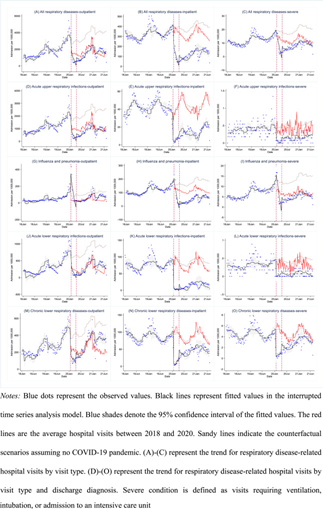Reduced inpatient and severe respiratory disease visits during COVID-19 in Wuhan, China
Published 04 February, 2024
In Wuhan, China, a stringent lockdown was implemented to contain the spread of COVID-19, transitioning to a normalised prevention and control strategy. Considering the shared transmission route through the respiratory tract, mask-wearing, social distancing, and personal hygiene have been linked to reduced transmission of respiratory pathogens other than SARS-CoV-2. However, there have been less investigation into the broader spectrum of respiratory diseases particularly in less developed countries.
In a new study published in the KeAi journal Global Transitions, a team of Chinese researchers examined the trends in hospital visits for acute and chronic respiratory diseases between 2018 and 2021 using the national health insurance data from Wuhan.
“Hospital visits for all the investigated diseases decreased during the lockdown period,” shares first author of the study Xuemin Zhu from Tsinghua University. “While visits for control conditions rebounded to pre-pandemic levels in the later normalised prevention and control period, visits for respiratory disease exhibit a more sustained impact from the pandemic.”
Notably, inpatient and severe condition visits for respiratory disease remained reduced even after the lockdown was lifted. Guanqiao Li, corresponding author of the study and also from Tsinghua University, emphasised that this research holds implications for future outbreak preparedness, healthcare resource allocation, and respiratory disease prevention and management.
“During the lockdown, community-level NPIs and government policies, particularly stay-at-home orders and travel restrictions have impeded patients’ access to healthcare services, primarily explaining the substantial decrease in hospital visits for all investigated diseases. Our findings underscore the importance of proactive preparedness by healthcare sectors to effectively manage outbreaks while ensuring the continued provision of essential medical services,” Li explains.
The team noted that the decrease in inpatient and severe condition visits for respiratory diseases upon the return to normal daily life is likely a result of the wide and consistent mask-wearing, social distancing, and personal hygiene improvement. While these reductions cannot be attributed to any single factor, the personal-level NPIs may have effectively reduced the incidence of severe respiratory diseases. Further, the researchers believe that healthcare systems should bolster their resilience to ensure rapid adaptability to diverse healthcare needs in the ongoing presence of the pandemics.

Image: Weekly hospital visits per million population in Wuhan between 2018 and 2021 across visit types and discharge diagnoses.
Contact author name, affiliation, email address: Guanqiao Li, Vanke School of Public Health, Tsinghua University, guanqiaoli@tsinghua.edu.cn
Funder: This study was funded by the National Natural Science Foundation of China (72374119), Tsinghua University lnitiative Scientifc Research Program of Precision Medicine (2022ZLA001) and Sanming Project of Medicine in Shenzhen (NO. SZSM202111001)
Conflict of interest: Guanqiao Li is an editorial board member, and Wannian Liang is the editor-in-chief for Global Transitions. They were not involved in the editorial review or the decision to publish this article. All authors declare that there are no competing interests.
See the article: Zhu, X., Liu, Y., Dai, W., Liang, W., & Li, G. (2024). Reduction in inpatient and severe condition visits for respiratory diseases during the COVID-19 pandemic in Wuhan, China. Global Transitions, 6, 37–44. https://doi.org/10.1016/J.GLT.2023.12.001

